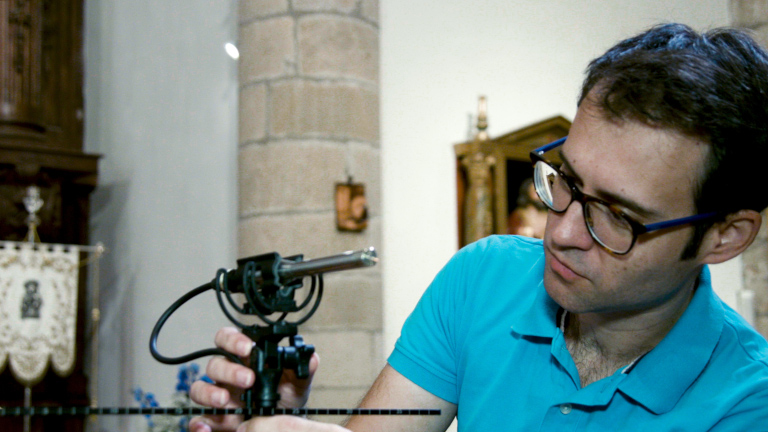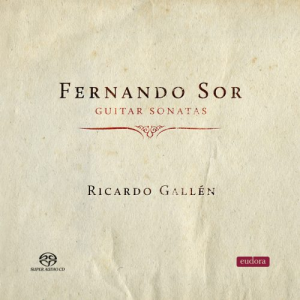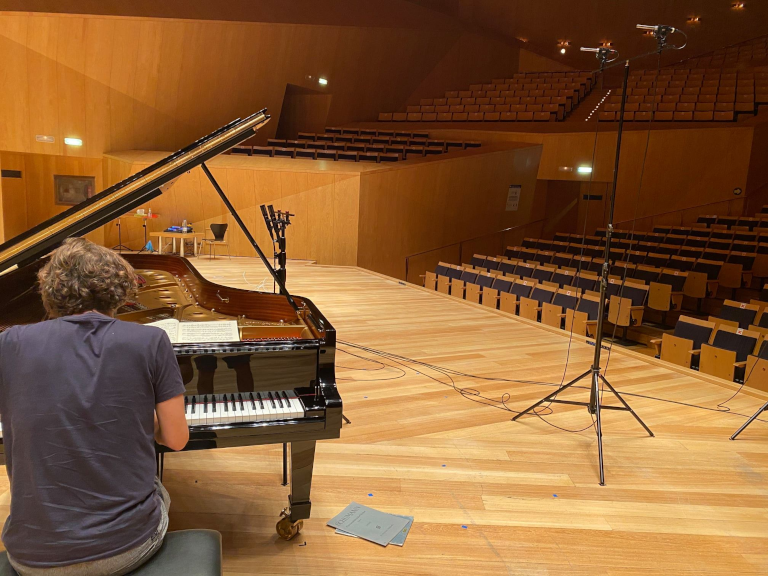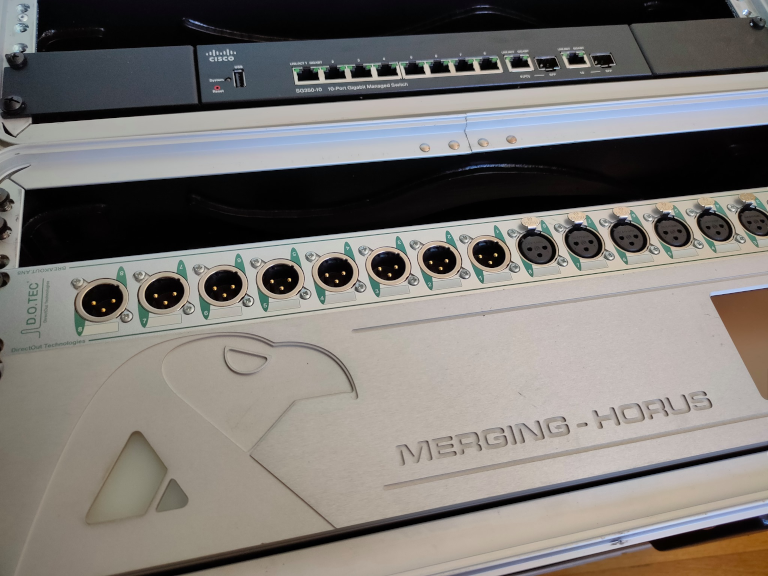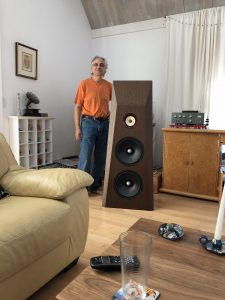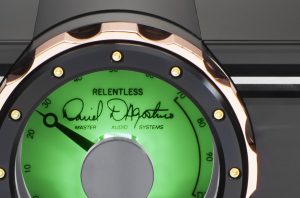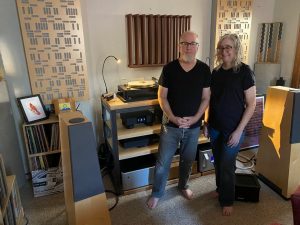I've been enjoying the wonderful recordings from Eudora Records for several months. I asked Gonzalo Noqué, founder and chief recording engineer, if he'd be willing to share a conversation about his label and recording philosophy. He agreed and we corresponded via email about some topics I thought Positive Feedback readers might find of interest. Enjoy.
Gonzalo Noqué setting up for a recording session.
Rushton Paul: What is your background and how did you come by your interest in music and making recordings?
Gonzalo Noqué: I have to admit that I cannot help but still consider myself primarily a musician, as this was my main training and occupation for many years (still most of my life). I was trained as a Classical guitarist in Madrid and in Salzburg. Since the beginning I had a strong attraction for the recording world and especially for the listening process and the equipment used to convey the emotions. I can say that I was an audiophile in spirit from the very beginning of my musical life. I strongly remember the time I bought my first pair of decent headphones: I was able to hear the conductor's breath and movement before the first note (it was Beethoven's First Symphony). So in a way my development as a musician was always connected with my love for recording Classical music.
Tell us about Eudora Records (when, why, how…)
It was actually something my wife had the idea of, back in 2011-2012. We were driving and she kind of had a revelation. It somehow seemed logical to us, considering what I was already doing and that both of us, as musicians, knew many talented fellow musicians. My audiophile side promptly emerged and the idea of DSD and the SACD was there from the very beginning. My good friend Ricardo Gallén, who was my teacher and is one of the best guitarists I'm aware of, decided to join for our first album, without knowing how things would turn out, something I'm very grateful to him for.
Tell us about your recording philosophy and what you seek to accomplish in making a recording.
I have the strong conviction that acoustics and microphone choice and placement of the main pair represent at least 98% of the final result sonic-wise, so that means that those three aspects are paramount. You will never obtain a great sounding album by recording in mediocre acoustics, not even the best engineer would be able to do that. So that's where all should start: choosing the right acoustic space.
Whenever I can, I choose omnidirectional microphones for the main pair, as they simply have the best tonal response (by far). In my opinion, directional microphones (although recordings made with them have fantastic localization) have an audible kind of "smear" to the phase response that make them sound tonally worse than omnis and to have a subtle grainy sound. My usual choice is Rens Heijnis' Sonodore RCM402; they are active powered and are just fabulous, tonally natural and true to the source, but never brittle, and have a unique way of portraying depth that it is extremely rare. I have some Schoeps and Neumann microphones also modified by Rens so they are active powered, which brings their performance to a new level.
Getting the main pair right on location is essential, trusting in placing lots of microphones so things can be fixed later rarely works. That doesn't mean that a recording has to be done with just two microphones, but even if you use dozens of them, the main pair has to be as perfect as possible.
Before I even place the microphones, I conceive in my mind the sound I want to hear considering that specific recording space and the given music and musicians. You have to rapidly choose from your available microphones and recording techniques those that will get you that sound, so you really need to know your microphones and those techniques! Then you have to find the right spot where the relationship between the direct sound and the space sound is optimal.
Recording session with Javier Laso showing mike setup for stereo/5-channel recording.
I also pay a lot of attention to something people hardly talk about: the main array height. I find that there's an audible effect as a result of the relationship between the main sound coming from the instruments and the reflection coming from the first surface, the floor. Modifying the height of the main pair results in different combinations of those two sounds and in my opinion, paying attention to it can be bring a new level of subtlety and magic in the resulting recorded sound.
Then come the width and angle of microphones, which correlate with the width and localization of the recorded sound. I also reposition the musicians (if they feel comfortable with it, of course) and sometimes the angle of the piano (when there is one). You can achieve outstanding results with these two details, the kind of differences you cannot get by using spot microphones or by changing anything in the main array.
Lastly, when acoustics and main microphone array are optimal, I find that recording in DSD is the perfect icing on the cake, as it delivers what I think is the best sound quality available today. DSD has changed quite a lot in the last years. Within the Merging Technologies Pyramix Workstation, editing points can remain purely in DSD (they are no longer converted in DXD). It is also possible to change gain in the DSD domain. What I find more exciting, Jussi Laako's HQ Player Pro is now able to mix within the DSD domain! So we've reached in a moment when recording, editing and mixing in DSD256 is indeed possible. For our latest release, Encounters with music for viola and piano, I've worked with Tom Caulfield from NativeDSD who has done the mixing work with HQ Player Pro.
Merging Technologies Horus A/D converter on location with Gonzalo Noqué.
Is there a recording engineer from the analog era of stereo recording whose work you particularly respect?
There are many, but there is one not much known whose work I specially admire: Pere Casulleras. His recordings of the Quatuor Mosaïques and Jordi Savall, for example, are fabulous, worth listening.
I have been struck by the very high quality of many of the artists you record. Can you talk a bit about how you came to work with some of these artists and what they expect of you in your working relationship with them?
I know it is going to sound strange coming from a label owner and producer, but virtually all projects simply come to me. In fact, from my experience, results tend to be better when you just allow the musicians to approach you when they feel they want to, and to freely choose what to record. Of course, that means I have to reject projects that I do not really like.
The artists I work with are not really aware of the technical side of the recordings I make (DSD, audiophile, all those things just don't belong to their vocabulary), but I think one of the things they trust most is the fact that I am also a musician and that I allow their free will to take control of the music being played in the recording sessions. I focus on trying to understand what they are trying to communicate and just point out what is not working that maybe they are not aware of. I never try to perform differently or the way I would like to hear, I "simply" make sure we will get their message as refined as possible.
And probably the most precious aspect of my experience recording over the years is the fact that I've worked with outstanding musicians, some of them absolutely wonderful human beings.
Of the recordings you've released over the years, do you have any that are particular favorites? Why? Can you tell us anything about projects coming up that have you particularly excited?
It would be very difficult choosing some recordings and probably bit unfair, but piano recordings have a special place for me. I have a very strong connection with the instrument and its repertoire, and I am especially proud of the piano recordings I have made. With regard to future releases, I was extremely fortunate and right after Spain's COVID lockdown in the first half of 2020 I made many recordings that I am very proud of. I think the sonics of those recordings are the best I have gotten so far and I worked with outstanding musicians recording music I deeply love, like Bach's violin and harpsichord sonatas, Schubert's D. 960 Sonata, Tchaikovsky's piano trio, or Shostakovich's cello sonata.
When (and why) did you start recording in both stereo and multi-channel in your recording sessions?
From the very beginning of Eudora Records I decided to record in multi-channel as I find this to be fantastic for Classical music, where the acoustics of the recording space are part of the music itself. I think I have a philosophy different from most engineers who record in multi-channel: I use cardioids microphones pointing to the hall for the rear channels, that is, microphones that reject the sound coming from behind them. That way, the rear channels basically have only room sound and no direct sound coming from the instruments. I know most producers use omnidirectional microphones for that, but I find that omnidirectional microphones give the rear channels a lot of direct sound coming from the instruments, and, in my opinion, the image clearly suffers when playing those rear channels together with the front ones.
Having good imaging is actually quite difficult in stereo. Adding two extra channels in the rear that "mess" with that is something I hear and it's not really my cup of tea. I like to think of the rear channels as extra acoustic energy that arrives to the listener at random incidence from the sides and behind from the hall, not from the musicians. This is what actually happens in real acoustics.
How is this period of COVID lockdowns and the need for social distancing impacting your recording activities? How do you see this impacting performing artists?
This period of social distancing and lockdown has been very hard on performing artists. Fortunately Spain is one of the few countries where concerts are indeed allowed, with limited capacity. That means that it has also possible to keep recording, something I feel extremely fortunate of.
All images courtesy of Eudora Records.
Don't miss the reviews of several Eudora Records albums that will be following this interview. The first two albums we're reviewing have been released in Pure DSD256 and are a real treat for the ears:
Schubert & Schumann, Javier Laso, Eudora Records (2021 (Pure DSD256) HERE
Encounters - Music for Viola & Piano, Enrique Bagaría, Joaquin Riquelme, Eudora Records (Pure DSD256) HERE
You may also find of interest the article Pure DSD256 - What We Hear to learn more about what Ganzolo is doing with his DSD256 recordings to obtain the exceptional transparency we enjoy.




